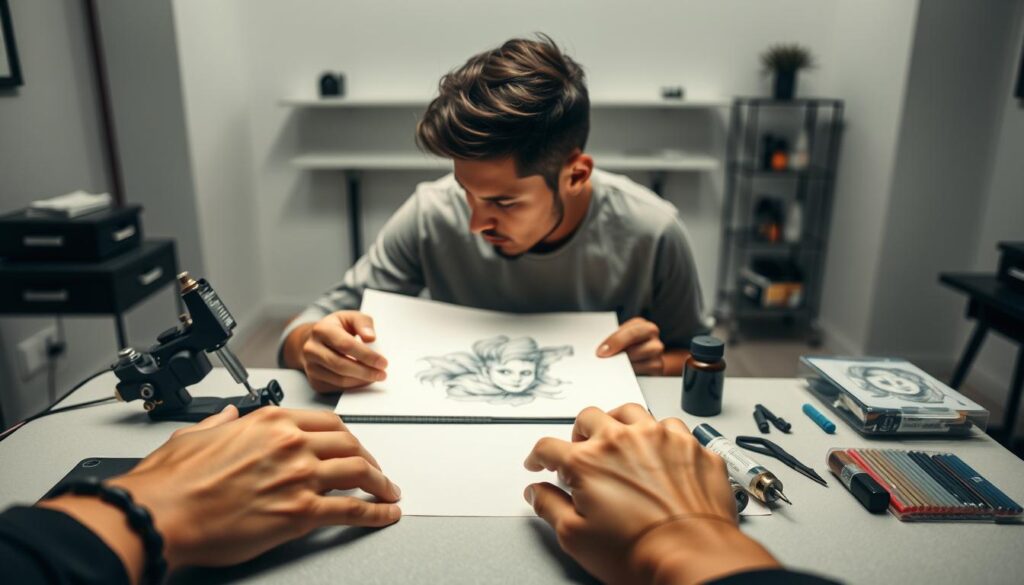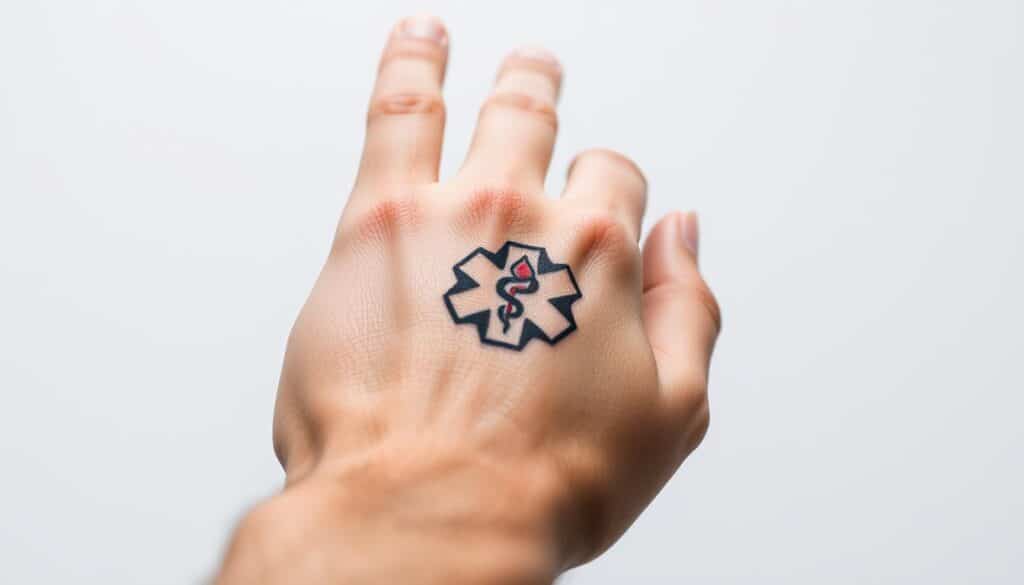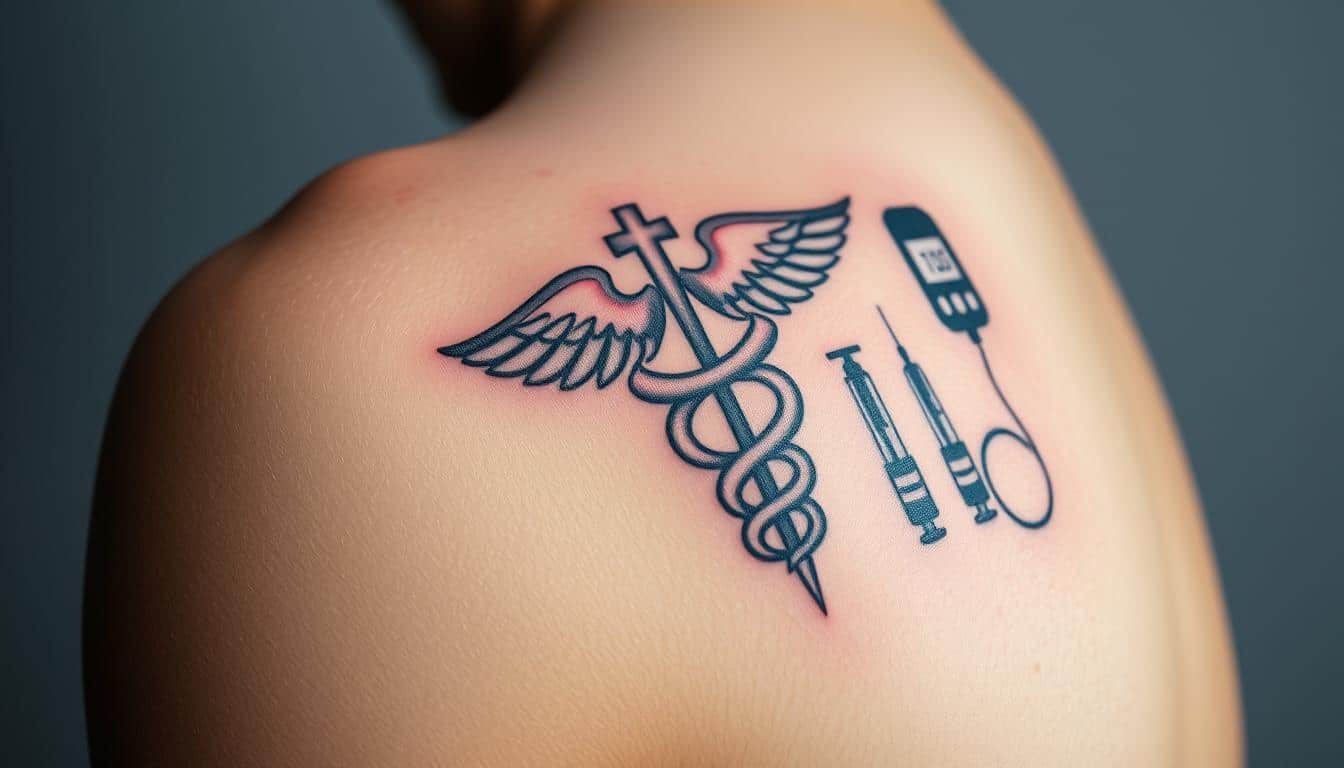Imagine marking a milestone in your health journey with meaningful body art. For many managing chronic conditions, tattoos serve as powerful symbols of resilience. One Virta Health member celebrated her diabetes reversal by etching her triumph into skin—proof that careful planning can turn aspirations into reality.
Success starts with preparation. Stable blood sugar levels are non-negotiable before sitting in the artist’s chair. Uncontrolled glucose slows healing and increases infection risks. Work closely with your doctor to ensure your numbers stay in range for weeks before and after the session.
Placement matters as much as preparation. Avoid extremities like ankles or wrists if you experience circulation challenges. Opt instead for fleshy areas with consistent blood flow. Reputable studios use single-use needles and medical-grade ink, reducing complications. Always verify their sterilization practices and artist certifications.
Even with perfect execution, know the warning signs. Redness spreading beyond the tattooed area or unusual swelling could signal trouble. Keep emergency contact numbers handy and act swiftly if symptoms escalate.
Body art becomes a safe possibility when paired with vigilance. Those who maintain tight control over their condition often find the rewards outweigh the risks. Let’s explore how to transform cautious optimism into a stunning personal statement.
Understanding Tattoos and Diabetes
Your skin acts as armor against germs, but needles create temporary weak spots in this defense system. For those managing blood sugar levels, this biological reality demands extra attention. Let’s examine how body art interacts with metabolic health.
Metabolic Factors in Body Art Safety
Elevated glucose levels create a double threat during tattooing. First, high blood sugar weakens white blood cells that fight infection. Second, it thickens blood vessels, slowing nutrient delivery to wounded areas. Research shows healing times increase by 30% when A1C exceeds 7%.
Your skin’s role becomes critical here. The tattooing process punctures its protective layer up to 3,000 times per minute. Damaged barriers let bacteria enter more easily—a concern compounded by diabetes-related nerve damage that might delay pain signals.
Healing Mechanics and Risk Alerts
Medical groups like the Diabetes Association emphasize individualized risk assessments. While no formal exists, endocrinologists universally recommend stable glucose for 6-8 weeks pre-procedure. This stability helps maintain skin elasticity and collagen production.
Watch for three key alert signs post-inking: yellow discharge, fever above 100.4°F, or expanding redness. These signal possible infection requiring immediate care. Those with type 1 diabetes often show symptoms faster than type 2 counterparts due to immune system differences.
Understanding your specific type of diabetes profile helps predict healing patterns. Share your medical history with both your artist and care team—transparency turns theoretical risks into manageable realities.
Preparing for Your Tattoo Session
Turning tattoo dreams into reality hinges on pre-session planning. Medical coordination and blood sugar management form the foundation of safe body art experiences. Start these preparations 8-10 weeks before your appointment to allow time for adjustments.

Medical Clearance and Glucose Tracking
Schedule a checkup with your physician first. Non-negotiable steps include reviewing your A1C—aim for under 7%—and assessing circulation health. Bring your glucose logs showing consistent readings between 80-180 mg/dL for three consecutive weeks.
Daily monitoring intensifies as your appointment nears. Test levels morning, noon, and night. The American Diabetes Association notes stress from pain can spike numbers—keep fast-acting carbs nearby during sessions.
Session Strategy and Safety Nets
Book shorter appointments (2-3 hours max) to prevent fatigue. Discuss break intervals with your artist—15 minutes every hour helps manage stress responses. Pack these essentials:
– Glucose tablets or juice boxes
– Protein-rich snacks
– Water bottle with measurement markers
Communicate openly about your needs. Artists appreciate knowing when to pause if you feel lightheaded. Post-session care begins immediately—schedule rest days and avoid taxing activities that could disrupt healing.
Can Diabetics Get Tattoos: Safety Precautions and Best Practices
Achieving a successful tattoo experience requires more than choosing a design—it demands strategic health management. Proper protocols turn potential risks into controlled outcomes when creating permanent body art.

Blood Sugar Stability: Your Healing Foundation
Consistent glucose levels act as your first defense against complications. Aim for an A1C below 7% and fasting readings between 80-130 mg/dL for six weeks pre-session. This stability supports collagen production and reduces infection risks by 40% compared to elevated levels.
Test your blood glucose morning and night during preparation. Bring a monitoring kit to your appointment—stress hormones can spike numbers unexpectedly. Artists appreciate clients who track metrics religiously.
Transparent Artist Collaboration
Disclose your condition when booking. Reputable tattoo artists adapt techniques for clients with circulation concerns. They might:
– Shorten session lengths
– Avoid areas with poor blood flow
– Use gentler needle depths
Verify studios use single-use needles and autoclave sterilization. Ask about their infection rates—professionals track this data. Your vigilance ensures the site remains protected during and after tattooing.
Partnership between you, your artist, and healthcare team creates optimal conditions. When all parties understand the science behind healing delays, everyone works toward the same goal: safe self-expression.
Managing Risks and Ensuring Proper Healing
The real work begins once the tattoo needle stops: safeguarding your art and health simultaneously. Compromised skin barriers demand hypervigilance—every step from cleaning routines to professional check-ins matters.
Identifying and Preventing Possible Infections
Watch for yellow-green discharge or skin that feels hotter than surrounding areas. These signs often appear faster than you’d expect—sometimes within 24 hours. The American Diabetes Association notes fever above 100.4°F warrants immediate healthcare contact.
Keep antibacterial soap handy during initial healing. Gently wash the area twice daily, patting dry with paper towels instead of cloth. Avoid soaking the tattoo in water for three weeks.
Aftercare Tips for Extended Healing Times
Moisturize with fragrance-free ointments containing zinc oxide. This mineral supports cell repair while creating a protective barrier. Reapply thin layers every 4-6 hours to prevent scabbing.
Schedule follow-ups with your artist and doctor. Share photos of healing progress—unusual swelling might indicate blood flow issues. Consistency turns extended recovery into manageable daily habits.
Make sure emergency contacts include both your dermatologist and endocrinologist. Pairing artistic expertise with medical alert protocols creates a safety net during vulnerable healing phases.
Choosing the Right Tattoo Artist and Studio
Your safety during body art creation hinges on studio selection as much as health management. Reputable professionals follow strict protocols that protect both your skin and long-term wellness. This decision impacts healing speed, infection risks, and overall success.
Evaluating Hygiene Practices and Sterile Equipment
FDA-mandated sterilization separates safe studios from risky ones. Verify artists use single-use needles and hospital-grade autoclaves for reusable tools. Check Better Business Bureau ratings for unresolved complaints about cleanliness or aftercare issues.
Visit studios personally before booking. Observe whether staff wear gloves during setup and dispose of materials properly. Ask about their infection rate tracking—ethical businesses monitor this data.
Maintain blood sugar control during sessions through frequent monitoring. Bring fast-acting glucose sources if procedures run longer than planned. Studios respecting your time constraints demonstrate understanding of metabolic health needs.
Prevent skin infections by confirming ink bottles remain sealed until use. Artists should unwrap sterilized equipment in front of clients. These practices reduce bacterial exposure by 72% compared to non-compliant studios.
Your collaborative approach—combining medical vigilance with artistic expertise—creates optimal conditions for meaningful body art. Prioritize facilities that value transparency over trendy decor.
Conclusion
Body art becomes a celebration of resilience when approached thoughtfully. With medical guidance and strategic preparation, permanent ink can safely become part of your story. Success hinges on collaboration—between you, healthcare providers, and skilled artists who prioritize hygiene.
Consult your care team first. Stabilize glucose levels for weeks beforehand. Choose studios using sealed needles and autoclaved tools. These steps reduce infection risks while supporting your body’s healing process.
Aftercare determines long-term results. Clean the area gently, monitor for unusual swelling, and maintain consistent check-ins with professionals. Properly managed, your tattoo can remain vibrant for years—a testament to both artistic vision and health discipline.
Revisit this roadmap whenever considering new body art. Each piece reflects careful planning and self-awareness. When executed wisely, the journey from concept to healed ink becomes its own powerful statement of control over life’s challenges.
FAQ
How does diabetes affect tattoo healing?
High blood glucose levels can slow skin repair and weaken immunity, increasing infection risk. Properly managed blood sugar and aftercare reduce complications. Consult your healthcare provider before proceeding.
Should you inform your tattoo artist about your condition?
Yes. Sharing your diagnosis helps the artist adjust techniques, prioritize hygiene, and avoid high-risk areas like feet. Reputable professionals follow ADA guidelines for clients with chronic conditions.
What blood sugar levels are safe for tattooing?
Aim for fasting glucose under 130 mg/dL and A1C below 7% for optimal healing. Uncontrolled levels may delay recovery or cause scarring. Monitor closely before and after sessions.
Are medical alert tattoos recommended?
The American Diabetes Association supports them as supplementary tools. Place these where EMTs can easily spot them, like wrists. Pair with traditional medical ID jewelry for reliability.
How long does healing take compared to non-diabetics?
Expect 2–4 weeks versus the typical 1–2 weeks. Follow studio aftercare rigorously, avoid soaking the area, and watch for redness or swelling. Report concerns to your doctor immediately.
Which body areas pose higher risks?
Feet, ankles, and lower legs have poorer circulation in many with diabetes. Opt for arms, chest, or thighs where blood flow supports faster recovery.
What studio hygiene practices are essential?
Verify autoclave-sterilized tools, single-use needles, and gloves. Studios registered with health departments often meet stricter standards. Avoid places reusing ink or neglecting surface disinfection.
Can insulin-dependent individuals get large tattoos?
Multi-session designs are possible if blood sugar remains stable. Schedule shorter appointments, take breaks to check levels, and hydrate. Discuss pain management strategies with your artist.


